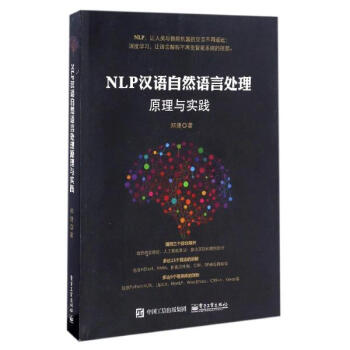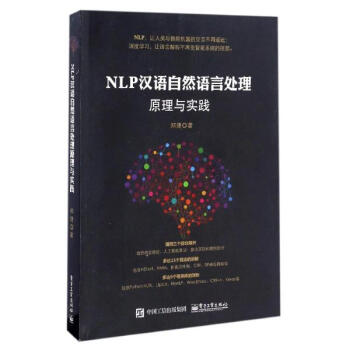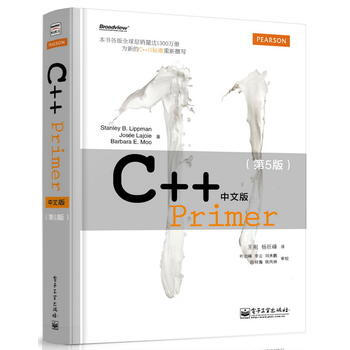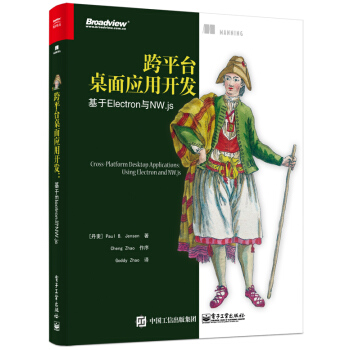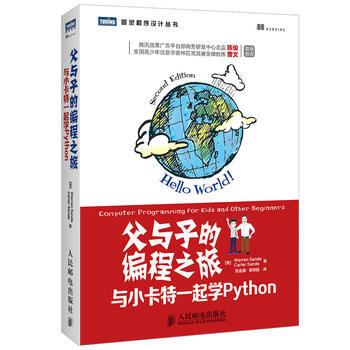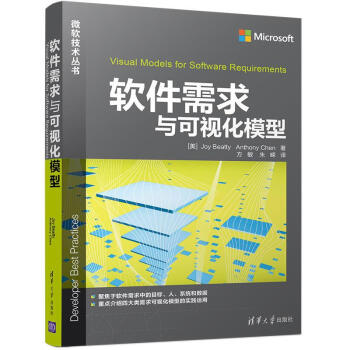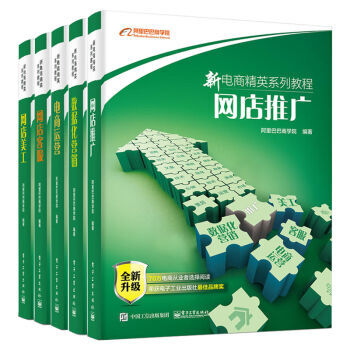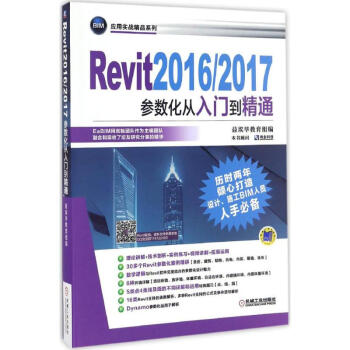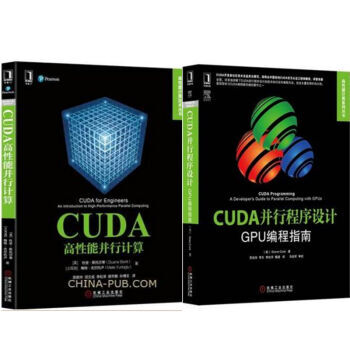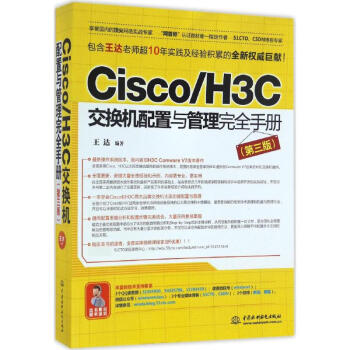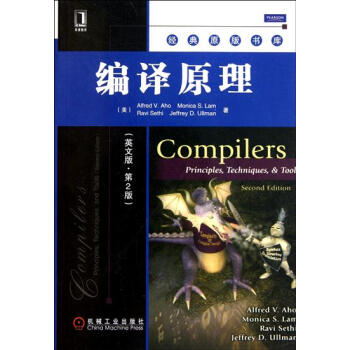

具体描述
| 书[0名0]: | 编译原理(英文版.[0第0]2版)(享有“龙书”的美誉,编译[0领0]域无可替代的经典著作)|197632 |
| 图书定价: | 78元 |
| 图书作者: | (美)Alfred V. Aho; Monica S. Lam; Ravi Sethi; Jeffrey D. Ullman |
| 出版社: | 机械工业出版社 |
| 出版日期: | 2011/1/1 0:00:00 |
| ISBN号: | 9787111326748 |
| 开本: | 32开 |
| 页数: | 1009 |
| 版次: | 2-1 |
| 作者简介 |
| Alfred V.Aho,美[0国0]歌伦比亚[0大0][0学0]教授,美[0国0][0国0]家工程院院士,ACM和IEEE[0会0]士,曾获得IEEE的冯·诺伊曼奖。著有多部算[0法0]、数据结构、编译器、数据库系统及计算机科[0学0]基础方面的著作。 Monica S.Lam,斯坦福[0大0][0学0]计算机科[0学0]系教授,曾任Tensilica的[0首0]席科[0学0]家,也是Moka5的[0首0]任CEO。曾经主持SUIF项目,该项目产生了流行的研究用编译器之一。 Ravi Sethi,Avaya实验室总裁,曾任贝尔实验室高级副总裁和Lucent Tech[0no0]logies通信软件的CTO。他曾在宾夕[0法0]尼亚州立[0大0][0学0],亚利桑那州立[0大0][0学0]和普林斯顿[0大0][0学0]任教,是ACM[0会0]士。 Jefirey D.Ullman斯坦福[0大0][0学0]计算机科[0学0]系教授和Gradiance CEO。他的研究兴趣包括数据库理论、数据库集成、数据挖掘和利用信息基础设施教[0学0]等。他是美[0国0][0国0]家工程[0学0]院院士、IEEE[0会0]士,获得过ACM的Karlstrom杰出教育奖和Knuth奖。 |
| 内容简介 |
| 本书是编译[0领0]域无可替代的经典著作,被广[0大0]计算机专业人士誉为“龙书”。本书上一版自1986年出版以来,被世界各地的著[0名0]高等院校和研究机构(包括美[0国0]哥伦比亚[0大0][0学0]、斯坦福[0大0][0学0]、哈佛[0大0][0学0]、普林斯顿[0大0][0学0]、贝尔实验室)作为本科生和研究生的编译原理课程的教材。该书对我[0国0]高等计算机教育[0领0]域也产生了重[0大0]影响。 [0第0]2版对每一章都进行了全面的修订,以反映自上一版出版20多年来软件工程。程序设计语言和计算机体系结构方面的发展对编译技术的影响。本书全面介绍了编译器的设计,并强调编译技术在软件设计和开发中的广泛应用。每章中都包含[0大0]量的习题和丰富的参考文献。 本书适合作为高等院校计算机专业本科生和研究生的编译原理与技术课程的教材,也可供广[0大0]计算机技术人员参考。 CD中包含如下内容: ·CompTIA Project+考试模拟题。 ·作者的项目管理培训视频。 ·项目管理工作表和模板。 |
| 目录 |
1 Introduction 1.1 Language Processors 1.2 The Structure of a Compiler 1.3 The Evolution of Programming Languages 1.4 The Science of Building a Compiler 1.5 Applications of Compiler Tech[0no0]logy 1.6 Programming Language Basics 1.7 Summary of Chapter 1 1.8 References for Chapter 1 2 A Simple Syntax-Directed TrAnslator 2.1 Introduction 2.2 Syntax Definition 2.3 Syntax-Directed Translation 2.4 Parsing 2.5 A Translator for Simple Expressions 2.6 Lexical Analysis 2.7 Symbol Tables 2.8 Intermediate Code Generation 2.9 Summary of Chapter 2 3 Lexical Analysis 3.1 The Role of the Lexical Analyzer 3.2 Input Buffering 3.3 Specification of Tokens 3.4 Recognition of Tokens 3.5 The Lexical-Analyzer Generator Lex 3.6 Finite Automata 3.7 From Regular Expressions to Automata 3.8 Design of a Lexical-Analyzer Generator 3.9 Optimization of DFA-Based Pattern Matchers 3.10 Summary of Chapter 3 3.11 References for Chapter 3 4 Syntax Analysis 4.1 Introduction 4.2 Context-Free Grammars 4.3 Writing a Grammar 4.4 Top-Down Parsing 4.5 Bottom-Up Parsing 4.6 Introduction to LR Parsing: Simple LR 4.7 More Powerful LR Parsers 4.8 Using Ambiguous Grammars 4.9 Parser Generators 4.10 Summary of Chapter 4 4.11 References for Chapter 4 5 Syntax-Directed Translation 5.1 Syntax-Directed Definitions 5.2 Evaluation Orders for SDD's 5.3 Applications of Syntax-Directed Translation 5.4 Syntax-Directed Translation Schemes 5.5 hnplementing L-Attributed SDD's 5.6 Summary of Chapter 5 5.7 References for Chapter 5 6 Intermediate-Code Generation 6.1 Variants of Syntax Trees 6.2 Three-Address Code 6.3 Types and Declarations 6.4 Translation of Expressions 6.5 Type Checking 6.6 Control Flow 6.7 Backpatching 6.8 Switch-Statements 6.9 Intermediate Code for Procedures 6.10 Summary of Chapter 6 6.11 References for Chapter 6 7 Run-Time Environments 7.1 Storage Organization 7.2 Stack Allocation of Space 7.3 Access to [0No0]nlocal Data on the Stack 7.4 Heap Management 7.5 Introduction to Garbage Collection 7.6 Introduction to Trace-Based Collection 7.7 Short-Pause Garbage Collection 7.8 Advanced Topics in Garbage Collection 7.9 Summary of Chapter 7 7.10 References for Chapter 7 8 Code Generation 8.1 Issues m the Design of a Code Generator 8.2 The Target Language 8.3 Addresses in the Target Code 8.4 Basic Blocks and Flow Graphs 8.5 Optimization of Basic Blocks 8.6 A Simple Code Generator 8.7 Peephole Optimization 8.8 Register Allocation and Assignment 8.9 Instruction Selection by Tree Rewriting 8.10 Optimal Code Generation for Expressions 8.11 Dynamic Programming Code-Generation 8.12 Summary of Chapter 8 8.13 References for Chapter 8 9 Machine-Independent Optimizations 9.1 The Principal Sources of Optimization 9.2 Introduction to Data-Flow Analysis 9.3 Foundations of Data-Flow Analysis 9.4 Constant Propagation 9.5 Partial-Redundancy Elimination 9.6 Loops in Flow Graphs 9.7 Region-Based Analysis 9.8 Symbolic Analysis 9.9 Summary of Chapter 9 9.10 References for Chapter 9 10 Instruction-Level Par[0all0]elism 10.1 Processor Architectures 10.2 Code-Scheduling Constraints 10.3 Basic-Block Scheduling 10.4 Global Code Scheduling 10.5 Software Pipelining 10.6 Summary of Chapter 10 10.7 References for Chapter 10 11 Optimizing for Par[0all0]elism and Locality 11.1 Basic Concepts 11.2 Matrix Multiply: An In-Depth Example 11.3 Iteration Spaces 11.4 Aftlne Array Indexes 11.5 Data Reuse 11.6 Array Data-Dependence Analysis 11.7 Finding Synchronization-Free Par[0all0]elism 11.8 Synchronization Between Par[0all0]el Loops 11.9 Pipelining 11.10 Locality Optimizations 11.11 Other Uses of Affine Transforms 11.12 Summarv of Chapter 11 11.13 References for Chapter 11 12 Interprocedural Analysis 12.1 Basic Concepts 12.2 Why Interprocedural Analysis? 12.3 A Logical Representation of Data Flow 12.4 A Simple Pointer-Analysis Algorithm 12.5 Context-Insensitive Interprocedural Analysis 12.6 Context-Sensitive Pointer Analysis 12.7 Datalog Implementation by BDD's 12.8 Summary of Chapter 12 12.9 References for Chapter 12 A A Complete Front End A.1 The Source Language A.2 Main A.3 Lexical Analyzer A.4 Symbol Tables and Types A.5 Intermediate Code for Expressions A.6 Jumping Code for Boolean Expressions A.7 Intermediate Code for Statements A.8 Parser A.9 Creating the Front End B Finding Linearly Independent Solutions Index |
用户评价
这本书给我的感觉,与其说是一本书,不如说是一部关于编译器的百科全书。我是在偶然的机会下接触到它的,当时我正在研究一门非常古老的编程语言,对它的解析过程感到困惑。偶然间,有人推荐了这本书,说它是编译领域的“圣经”。我带着好奇心翻开它,结果被深深吸引住了。书中的内容涵盖了编译器的几乎所有方面,从最基础的词法分析,到复杂的代码优化和目标代码生成,都做了详尽的论述。我尤其对书中关于语法制导翻译的介绍印象深刻,它展示了如何将语法规则与语义动作相结合,从而完成对程序语义的计算。书中还详细介绍了各种编译器设计中的权衡和取舍,例如在解析器选择上的不同策略,以及在代码生成过程中如何平衡代码质量和编译速度。这本书没有回避任何技术细节,而是以一种非常系统和全面的方式,为读者展示了构建一个编译器所需的全部知识。对于那些想要深入了解编译器工作原理,或者想要自己动手编写编译器的人来说,这本书绝对是不可多得的宝藏。它为我打开了一扇通往计算机底层世界的大门,让我对程序语言的本质有了更深刻的理解。
评分我是一名计算机科学专业的学生,在学习编译原理这门课程时,这本书是我们绕不开的“圣经”。刚开始接触这本书的时候,我确实被它的深度和广度所震撼。它不像某些教科书那样,为了便于理解而简化概念,而是直接呈现了最核心、最本质的理论。阅读这本书的过程,就像是在攀登一座高峰,每一步都需要付出艰辛的努力。我花了大量时间去理解图灵机、上下文无关文法、以及各种解析算法的数学原理。很多时候,我需要借助其他资料,比如在线视频、博客文章,来辅助我理解书中的某些晦涩概念。但是,当我对某个复杂的算法,比如 LR 解析器,终于有了透彻的理解时,那种豁然开朗的感觉是无与伦比的。这本书塑造了我严谨的学术态度,让我学会了如何去批判性地思考,如何去追根溯源。它不仅仅是为考试而准备的教材,更是为我未来在计算机科学领域的探索奠定了坚实的基础。即使是在完成课程之后,我依然会时不时地翻阅这本书,每一次都会有新的收获。它让我明白,计算机科学并非是简单地学习一些编程语言和工具,而是要理解其背后深刻的理论和原理。
评分这本书实在是太厚了,拿在手里沉甸甸的,仿佛承载着整个计算机科学领域的重量。我拿到它的时候,正值我对计算机底层运作原理充满好奇的时期。翻开第一页,就立刻被那些密密麻麻的公式和抽象的定义所吸引。虽然一开始觉得有点望而生畏,但随着阅读的深入,我渐渐体会到它所蕴含的逻辑之美。作者们用严谨的数学语言构建了一个完整的理论体系,从词法分析到语法分析,再到中间代码生成和优化,每一步都环环相扣,精妙绝伦。我花了很长时间去理解其中的递归下降解析,以及各种抽象语法树的构造。有时候,为了弄懂一个概念,我会反复阅读几遍,对照着书中的例子,甚至自己动手画图。这种艰辛的学习过程,虽然耗费了大量的精力和时间,但最终带来的却是巨大的成就感。我开始能够理解编译器是如何工作的,它是如何将我们人类易于理解的代码,转换成机器能够执行的指令。这种“看见”底层运作的体验,对我来说是前所未有的。这本书不仅提供了理论知识,更重要的是,它教会了我一种思考问题的方式,一种用严谨、系统化的方法去分析和解决复杂问题的能力。即使现在,我偶尔还会翻阅其中的一些章节,温故而知新,总能从中发现新的理解和启发。
评分作为一个在软件开发一线摸爬滚打多年的工程师,我接触过形形色色的技术书籍,但真正能称得上“宝藏”的却屈指可数。这本书无疑就是其中的佼佼者。它不像那些泛泛而谈、不痛不痒的入门读物,而是深入骨髓地剖析了编译器的核心机制。我记得在我刚开始接触系统编程的时候,对程序的执行过程总是有种模糊的认识,直到我开始认真啃读这本书。作者们对各个环节的描述,从词法分析的有限自动机,到语法分析的上下文无关文法,再到代码生成和优化的各种算法,都做到了详尽且清晰的阐释。尤其是关于代码优化的部分,让我对如何写出更高效的代码有了全新的认识。书中提出的各种优化技巧,如常量折叠、死代码消除、循环不变外提等,都非常有实践指导意义。我曾经尝试根据书中的理论,为自己开发的一个小工具编写了一个简易的编译器,虽然功能有限,但整个过程极大地提升了我对程序运行效率的敏感度。这本书不仅仅是理论的堆砌,它更是实践的基石。它教会了我如何从抽象的理论出发,构建出能够解决实际问题的工具。这本书的价值,在于它能够让你真正理解“代码是如何变成可执行程序的”,这种底层理解,对于任何想要深入理解计算机科学的人来说,都是不可或缺的。
评分拿到这本书的时候,我是一名初涉软件工程的学生,对“编译”这个概念还停留在非常模糊的阶段。这本书的篇幅和深度,让我一开始有些望而却步。它不像市面上那些轻松易读的教程,而是以一种极其严谨和学术的风格,深入浅出地剖析了编译器的每一个组成部分。我花了很长时间去消化书中的内容,尤其是关于形式语言和自动机理论的章节,它们为理解词法分析和语法分析奠定了坚实的理论基础。书中的数学公式和证明,虽然一开始看起来有些令人望而生畏,但正是这些严谨的理论,构建了编译器设计的逻辑根基。我记得为了理解其中的递归下降解析器,我曾画了无数张图,试图弄清楚每一步的推导过程。这本书教会了我,理解一个复杂的系统,需要从最基本的原理入手,层层递进。它不仅仅是一本关于编译器的书,更是一本关于如何进行严谨科学研究的典范。它的价值在于,它能够培养读者独立思考、深入钻研的能力,以及对计算机科学底层原理的深刻洞察。即便过去了很久,我依然认为这本书是我学习道路上最重要的里程碑之一。
相关图书
本站所有内容均为互联网搜索引擎提供的公开搜索信息,本站不存储任何数据与内容,任何内容与数据均与本站无关,如有需要请联系相关搜索引擎包括但不限于百度,google,bing,sogou 等
© 2026 book.tinynews.org All Rights Reserved. 静思书屋 版权所有


